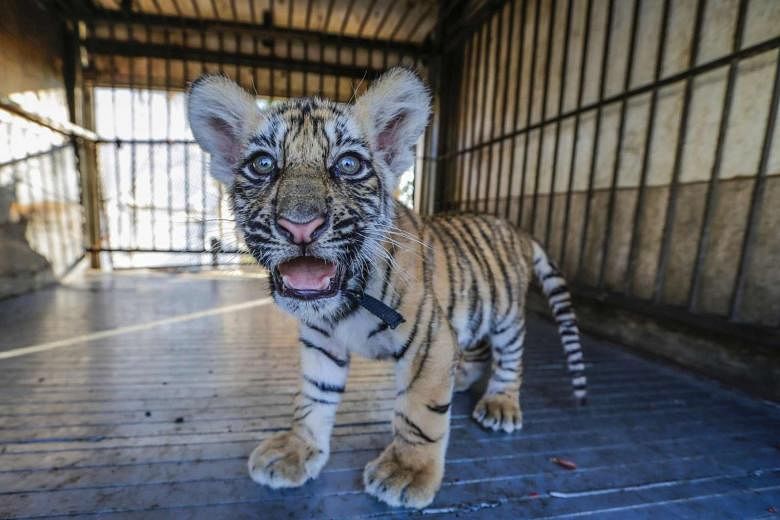A high-profile international conference on tiger conservation, opened by Indian Prime Minister Narendra Modi, concluded in New Delhi last week calling for new impetus to protect the tiger, even as the international media lauded a rise in tiger numbers.
There were 3,200 tigers in 2010 and 3,890 today.
A little sober reflection is in order, though. Tiger numbers are indeed higher, but this time around the counting methodology was more rigorous and more areas were covered than in 2010. They are also not quite a gold standard; four prominent tiger biologists from three prominent scientific and conservation organisations on Saturday (April 16), in a "statement of concern", questioned the methodology and essentially urged caution.
Going by the number released by the World Wildlife Fund (WWF), actual numbers of tigers may indeed have risen. However, it is probably more accurate to say there are more tigers in the wild than previously estimated.
That is still of course good news - but only in some countries. India has more tigers than any other country, but this doesn't mean tigers are out of the woods even in India, not to speak of mainland South-east Asia.
The fact that tigers have in the same space of time lost a huge chunk of their historic range in Laos, Cambodia and Vietnam - where they are now functionally extinct - has been buried in the media coverage.
The fact that there are some 7,000 tigers in "farms" across China and Indochina, which leak tiger parts into the market, was also not mentioned in the New Delhi declaration. These farms create a laundering opportunity for tigers killed in the wild.
And left out of the New Delhi resolution too was a controversial plan to repopulate Cambodia's forests with tigers from India.
In a post-conference statement, 24 non-government organisations, both Indian and international, said conservation successes could only occur in countries "with strong laws and where wild tigers are valued for their role in the ecosystem".
These would not happen in countries "where tiger farming exists and they are valued only as a commodity".
"The (New Delhi) resolution… stopped short of addressing the supply of tiger parts and derivatives from tiger 'farms' which feed legal and illegal trade, both domestic and international, and perpetuate demand."
One does not have to look far for a cynical conclusion about rule of law in mainland South-east Asia. The Tiger Temple near Kanchanaburi in Thailand, a money-spinning tourist attraction whose tigers have been mysteriously multiplying, faces accusations not only of animal abuse but of surreptitious tiger breeding and trading. It has openly defied a government agency armed with court orders requiring it to close down.
And across the Mekong from Chiang Rai province, at the Kings Romans casino complex in Laos, tigers sit in cages, and tiger products are openly sold.
"Tiger skins, meat, teeth, claws, bones and bone products from wild and farmed tigers are still consumed in China and Vietnam and by Chinese consumers in Lao PDR and Myanmar," says the joint statement of the conservation organisations. ''The trade in tiger parts and products is undertaken by organised criminal networks raising serious concerns about the survival of tigers in the wild.''
The number of facilities breeding and keeping captive tigers help to supply and stimulate the market. ''Laws in China and Lao PDR allow the trade in parts and products of captive tigers, and the licensed domestic trade in the skins of zoo and farm tigers has been well documented in China," the statement said.
Meanwhile, the WWF-championed plan to transfer India's tigers to Cambodia with a clarion call to "double tigers" has divided experts.
"Once a sourcing agreement has been finalised with India and the preparations are complete in Cambodia (such as the construction of tiger release enclosures and preparation of veterinary facilities), the identified tigers will be tranquillised in India and given thorough health checks before being transported to Cambodia,'' the WWF says on its Cambodia website.
Few disagree that it is a good idea to repopulate areas that have lost tigers. But such areas must have a sufficient prey base and be adequately protected.
It is not an accident that tigers have become extinct in Cambodia, and are nearly extinct in Laos and Vietnam. There is a pervasive hunting culture throughout the region, and the tigers are close to the biggest market for tiger parts - China.
In Cambodia, corruption is endemic and the rule of law is weak. Cambodia has had the fastest rate of deforestation in the world. According to one estimate, nearly one third of forest cover lost in Cambodia in 2014 disappeared from inside legally-protected areas.
Cambodia unveiled its Tiger Action Plan this month, which was seen as a significant step. But publishing plans is the easy part. Cambodia could not protect its tigers when it had them.
Conservationists say there must be significant guaranteed protection and obvious political will before the tigers are taken from the wild in India and sent to Cambodia. The process should be transparent, and there should be independent monitoring of progress.
India-based wildlife biologist Raghu Chundawat, speaking to Livemint news website last week, said: "It is a great idea; we want tigers in all range countries but there are a few considerations. Obvious ones are about Cambodia's ability and preparedness."
Unsurprisingly the budgets are considerable. It is estimated that eight tigers will be required for the exercise, which will cost between US$20 million (S$27 million) and US$50 million, Cambodia's Ministry of Agriculture and WWF-Cambodia announced this month.
There has been talk in private meetings of "conflict tigers", or tigers that have clashed with people - by killing livestock for instance - on the peripheries of India's tiger reserves, being eyed for relocation to Cambodia. Dr Thomas Gray, of WWF-Mekong, on Twitter on Saturday insisted that WWF would robustly monitor tiger prey numbers and law enforcement, and if there was any poaching activity there would be no reintroduction.
The stakes are high. Dr Ullas Karanth, a tiger expert with the US-based Wildlife Conservation Society (WCS) warned this week of the risk of "tragic failure".
"The idea of translocating captive-bred or wild caught problem tigers from India to Cambodia is bereft of any ecological understanding or even of the Cambodian social context," Dr Karanth said.
Given the realities of Cambodia, if this scheme goes ahead and pictures of trapped tigers being taken to Cambodia emerge in the Indian media, there will be questions whether it is not more feasible to repopulate areas with sub-optimal tiger populations in India - of which there are several - rather than send them to an uncertain fate in Cambodia.
Any mishap, critics say, will trigger a backlash that will sink the project and give tiger conservation a bad name.
The writer is a Trustee of The Corbett Foundation, one of the NGOs that signed on to the post-conference statement referred to in this article.


